Dickens简介
- 格式:ppt
- 大小:895.00 KB
- 文档页数:27
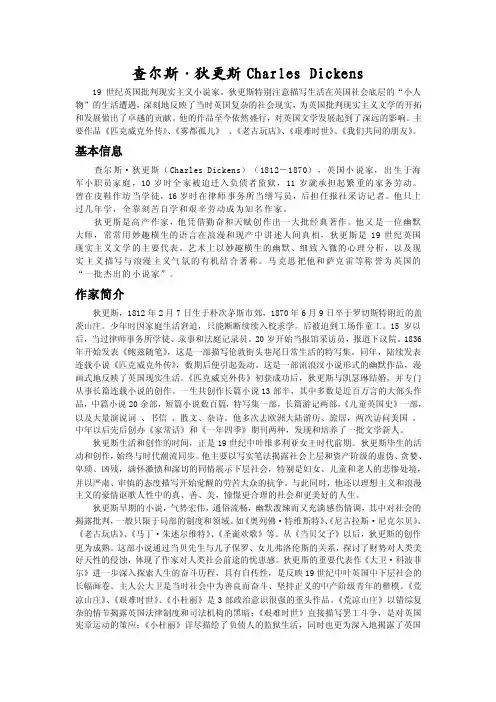
查尔斯·狄更斯Charles Dickens 19世纪英国批判现实主义小说家。
狄更斯特别注意描写生活在英国社会底层的“小人物”的生活遭遇,深刻地反映了当时英国复杂的社会现实,为英国批判现实主义文学的开拓和发展做出了卓越的贡献。
他的作品至今依然盛行,对英国文学发展起到了深远的影响。
主要作品《匹克威克外传》、《雾都孤儿》、《老古玩店》、《艰难时世》、《我们共同的朋友》。
基本信息查尔斯·狄更斯(Charles Dickens)(1812-1870),英国小说家,出生于海军小职员家庭,10岁时全家被迫迁入负债者监狱,11岁就承担起繁重的家务劳动。
曾在皮鞋作坊当学徒,16岁时在律师事务所当缮写员,后担任报社采访记者。
他只上过几年学,全靠刻苦自学和艰辛劳动成为知名作家。
狄更斯是高产作家,他凭借勤奋和天赋创作出一大批经典著作。
他又是一位幽默大师,常常用妙趣横生的语言在浪漫和现产中讲述人间真相,狄更斯是19世纪英国现实主义文学的主要代表。
艺术上以妙趣横生的幽默、细致入微的心理分析,以及现实主义描写与浪漫主义气氛的有机结合著称。
马克思把他和萨克雷等称誉为英国的“一批杰出的小说家”。
作家简介狄更斯,1812年2月7日生于朴次茅斯市郊,1870年6月9日卒于罗切斯特附近的盖茨山庄。
少年时因家庭生活窘迫,只能断断续续入校求学。
后被迫到工场作童工。
15岁以后,当过律师事务所学徒、录事和法庭记录员。
20岁开始当报馆采访员,报道下议院。
1836年开始发表《鲍兹随笔》,这是一部描写伦敦街头巷尾日常生活的特写集。
同年,陆续发表连载小说《匹克威克外传》,数期后便引起轰动。
这是一部流浪汉小说形式的幽默作品,漫画式地反映了英国现实生活。
《匹克威克外传》初获成功后,狄更斯与凯瑟琳结婚,并专门从事长篇连载小说的创作。
一生共创作长篇小说13部半,其中多数是近百万言的大部头作品,中篇小说20余部,短篇小说数百篇,特写集一部,长篇游记两部,《儿童英国史》一部,以及大量演说词、书信、散文、杂诗。
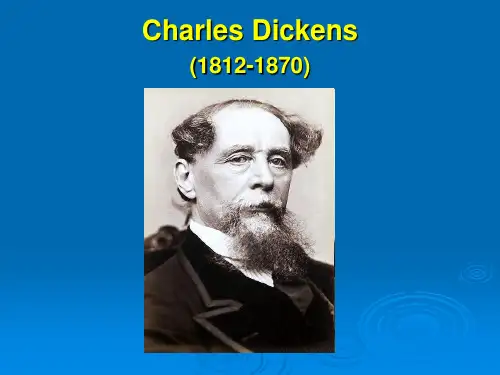
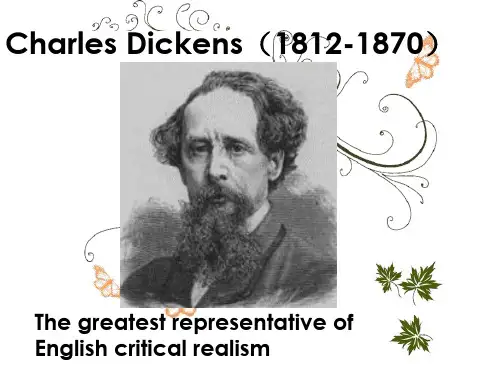
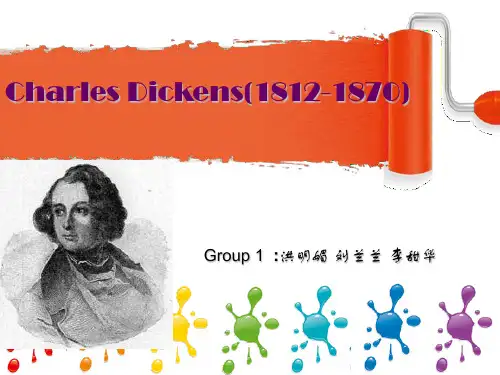
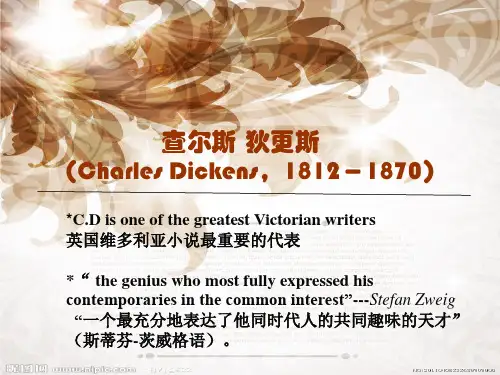
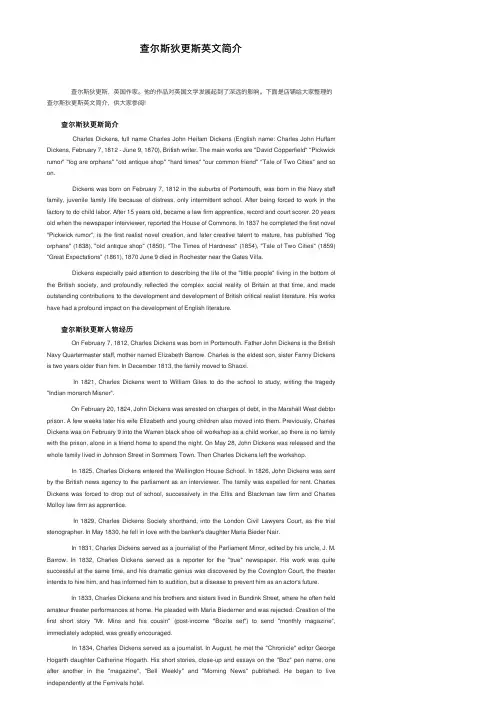
查尔斯狄更斯英⽂简介 查尔斯狄更斯,英国作家。
他的作品对英国⽂学发展起到了深远的影响。
下⾯是店铺给⼤家整理的查尔斯狄更斯英⽂简介,供⼤家参阅! 查尔斯狄更斯简介 Charles Dickens, full name Charles John Heifam Dickens (English name: Charles John Huffam Dickens, February 7, 1812 - June 9, 1870), British writer. The main works are "David Copperfield" "Pickwick rumor" "fog are orphans" "old antique shop" "hard times" "our common friend" "Tale of Two Cities" and so on. Dickens was born on February 7, 1812 in the suburbs of Portsmouth, was born in the Navy staff family, juvenile family life because of distress, only intermittent school. After being forced to work in the factory to do child labor. After 15 years old, became a law firm apprentice, record and court scorer. 20 years old when the newspaper interviewer, reported the House of Commons. In 1837 he completed the first novel "Pickwick rumor", is the first realist novel creation, and later creative talent to mature, has published "fog orphans" (1838), "old antique shop" (1850), "The Times of Hardness" (1854), "Tale of Two Cities" (1859) "Great Expectations" (1861), 1870 June 9 died in Rochester near the Gates Villa. Dickens especially paid attention to describing the life of the "little people" living in the bottom of the British society, and profoundly reflected the complex social reality of Britain at that time, and made outstanding contributions to the development and development of British critical realist literature. His works have had a profound impact on the development of English literature. 查尔斯狄更斯⼈物经历 On February 7, 1812, Charles Dickens was born in Portsmouth. Father John Dickens is the British Navy Quartermaster staff, mother named Elizabeth Barrow. Charles is the eldest son, sister Fanny Dickens is two years older than him. In December 1813, the family moved to Shaoxi. In 1821, Charles Dickens went to William Giles to do the school to study, writing the tragedy "Indian monarch Misner". On February 20, 1824, John Dickens was arrested on charges of debt, in the Marshall West debtor prison. A few weeks later his wife Elizabeth and young children also moved into them. Previously, Charles Dickens was on February 9 into the Warren black shoe oil workshop as a child worker, so there is no family with the prison, alone in a friend home to spend the night. On May 28, John Dickens was released and the whole family lived in Johnson Street in Sommers Town. Then Charles Dickens left the workshop. In 1825, Charles Dickens entered the Wellington House School. In 1826, John Dickens was sent by the British news agency to the parliament as an interviewer. The family was expelled for rent. Charles Dickens was forced to drop out of school, successively in the Ellis and Blackman law firm and Charles Molloy law firm as apprentice. In 1829, Charles Dickens Society shorthand, into the London Civil Lawyers Court, as the trial stenographer. In May 1830, he fell in love with the banker's daughter Maria Bieder Nair. In 1831, Charles Dickens served as a journalist of the Parliament Mirror, edited by his uncle, J. M. Barrow. In 1832, Charles Dickens served as a reporter for the "true" newspaper. His work was quite successful at the same time, and his dramatic genius was discovered by the Covington Court, the theater intends to hire him, and has informed him to audition, but a disease to prevent him as an actor's future. In 1833, Charles Dickens and his brothers and sisters lived in Bundink Street, where he often held amateur theater performances at home. He pleaded with Maria Biederner and was rejected. Creation of the first short story "Mr. Mins and his cousin" (post-income "Bozite set") to send "monthly magazine", immediately adopted, was greatly encouraged. In 1834, Charles Dickens served as a journalist. In August, he met the "Chronicle" editor George Hogarth daughter Catherine Hogarth. His short stories, close-up and essays on the "Boz" pen name, one after another in the "magazine", "Bell Weekly" and "Morning News" published. He began to live independently at the Fernivals hotel. In 1835, Charles Dickens was engaged with Catherine Hoghes. His stories, close-ups and essays continue to be published in the Monthly Magazine, The Chronicle, and Bell's Life in London. 1836, February 8, "Bozite set" first series published. March 31, the first novel "Pickwick rumor" by Chapman and Hall Press began monthly by section published (20 months out). On April 2, Charles Dickens married Catherine Hoggas at St. Louis' s church in Chelsea and immediately went to Kent honeymoon. 9 -12 months, the drama "strange gentleman" and "Qiao village" in the St. James Theater staged. In December, he became acquainted with John Foster, who became his lifelong friend and biographer (three volumes of The Dickens Biography) published in 1872-1874). December 17, "Bozite set" second series published. January 1, 1837, Charles Dickens editor of the monthly magazine "Bentley magazine" first issue. The second issue of the journal serialized his "Oliver Te West" (24 months finished). On January 6th, Charles Dickens's first child (Charles) was born. March, the play "Is she his wife?" Staged at the St. James Theater. In July, the first visit to Europe. November 17, "Pickwick rumor" single book published. 1838 January and February, accompanied by H. K. Brown interviewed Yorkshire school. The second child (Mary) was born. On March 31, we began to publish "Nicholas Nickel Bay" (20 months out). November 9, "Oliver Te West" (fog orphans) published a single book. January 31, 1839, resigned from the "Bentley magazine" editor in chief. The third child (Kate) was born. On October 23rd, "Nicholas Nickel" was published separately. April 4, 1840, editor of the literary weekly "Humphrey master of the bell" first issue. April 25, "old antique shop" in the weekly sub-series (40 weeks finished). In October, "Humphrey Master's Bell" was published in the first volume. In 1841, the fourth child (Walter) was born. February 13, "Barnaby Rach" in the "Humphrey Master's Bell" weekly on the serial (42 weeks finished). April, December, "Humphrey master of the bell" single book second volume, third volume published. December 5, "old antique shop", "Barnaby Rach" single book published. From January to June 1842, his wife visited the United States. 10 - 11 months, accompanied by Foster and other visits to Cornwall. October 19, "travel beauty notes" published. On December 31, Martin Jussewell Witt began to be published monthly by Chapman and Hall Publishing (20 months out). October 5, 1843, hosted the opening ceremony of the Manchester Literary Association. December 19, "Christmas carol" (post-income "Christmas story set") published. In 1844, the fifth child (Francis) was born. With Chapman and Hall Press, the book was revised by Bradbury and Evans Press. In July, "Martin Jussewell Witt" published a single book. July 16, to live in Genoa, Italy. November 30 to December 8, back to London to read the "church bells" to friends. December 16, "Church Bell" (post-income "Christmas Stories") published. In 1845, his wife visited Naples. In September, amateur performance Ben Jiong's drama "Everyone is happy". The sixth child (Alfred) was born. December 20, "Fireside Cricket" (post-income "Christmas Stories") published. January 21, 1846 to February 9, editor of "Daily News". May 18, "Italian style" published. June 11 to November 16, to live in Lausanne, Switzerland, after going to Paris. September 30, "Dong Bei father and son" began month by month published (20 months out). December 19 "Battle of Life" (post-income "Christmas Stories") published. February 28, 1847, returned from Paris to London. The seventh child (Sidney) was born. In April 1848, "Dong Bei father and son" published a single book. May-July, amateur directors and performances in London and outside. December 19, "the devil man" (after the income "Christmas story set") published. In 1849, the eighth child (Henry) was born. On April 30, "David Copperfield" began to be published month by month (20 months out). The ninth child (Dora) was born in 1850. And Bewei Li Dayton to create a literary association. March 30, editor of literary weekly Since January 1851, "Children's British History" began in the "homely" weekly serial. Held amateur theater performances at Lucken Mumburg. April 14, daughter Dora died. In 1852, the tenth child (Edward) was born. In the north show Bu Wei a Li Dayton drama. In October, go to the French Poloni holiday. "Desolate Villa" began to be published month by month (20 months out). "Christmas story set" single book published. In 1853, living in the French Poloni. Chicken Wilke Collins Tour Switzerland. In September, "desolate Villa" single book published. On December 27th, in Birmingham for the first time held a public recitation performance, recitation "Christmas carol". In 1854, in January, visit Lancashire Preston. Summer to France Poloni. April 1 to August 12, "difficult times" in the "homely" on the serial, the same year out of the book. In February 1855, with Maria Biederner reunion, then she has become a wife of Wende. In June, he directed and performed Collins' "Lighthouse". Participate in the Administrative Reform Association. In October, the family went to Paris to live. December 1, "small Du Li" began month by month published (20 months out of Qi). In March 1856, buy the village of Gates. April, back to the UK. In January 1857, director and performance of the drama of Collins "deep ice." Andersen visits Gates to visit Dickens. Playing in Manchester with the actress Ellen Ternan and his mother, his sister get to know. "Little Du Li" single book published. In October, the two lazy apprenticeships, co-authored with Collins, were published in "homely". April 29, 1858 to July 22, held in London business recitation performance. May, separated from his wife Catherine, the community have talked about. June 12, in the "homely" published on their own family disputes statement. August 2 to November 13, held in England, Scotland and Ireland throughout the first tour recitation performance. April 30, 1859, Dickens editor of the literary weekly "year round" the first issue, the first issue of serial number "Tale of Two Cities", to November 26 end. In the same year, May 28, "homely" the last issue of the publication. In October, a second tour recitation was held. In 1860, the second woman Kate Dickens married Charles Collins (Wilji's brother). Charles Dickens settled in Gates Villa. January 28, "non-travel salesman notes" began in the "four seasons" on the serial. December 1, "great future" began in the "year round" on the serial. 1861, March-April, held in London recitation performance. August, "lofty future" single book published. "Non Travel Traveler Notes" is published separately. October to January the following year, to the field held recitation performances. 1862, March-June, held in London recitation performance. In January 1863, the British Embassy in Paris held a recital performance for charity purposes. On May 1, 1864, "our common friends" began to be published month by month (20 months out). June 9, 1865, and Alan Ternan travel by train in Kent, Sri Lanka, a car accident. In November, "our common friend" is published separately. December, "Non Travel Travelers Notes" second edition published. 1866 April-June, held in London and abroad recitation performance. From January to May in 1867, recitation performances were held in England and Ireland. In November, went to the United States to carry out recitation performances. The last Christmas story "This road is not available" (with Collins) in the "year round" published. On April 22, 1868, the United States returned to England. October, held a farewell recitation performance. January 5, 1869, recitation performance "Oliver Te West" in the "Sikes Khan Nancy" chapter. April 22, due to health reasons to suspend recitation performance. In 1870 January, held in London 12 farewell recitation performances. March 9, received by the Queen Victoria. April 1, "Druid's mystery" began to sub-published (plan divided into 12, died only completed 6). June 9, suffering from cerebral hemorrhage died in the Gates Villa. After his death he was buried at the Cape of the Westminster, and his tombstone wrote: "He is a poor, suffering and sympathetic to the oppressed people; his death has left the world a great British writer." 查尔斯狄更斯个⼈⽣活 Dickens 18 years old that year in the family between the small theater troupe met Maria Pittel. Maria is the daughter of a small banker, much better than the poor family Dickens. Her parents strongly disagreed with the exchanges between them, combined with Maria is not a serious woman to treat life, since the two sides feel that each other's love of Dickens summon the courage to talk to Maria after the love suffered a cold refused. The experience of Dickens in the mind carved a deep imprint, so that he contemptuous reality of women and love fantasy ideal women. In the "Pickwick rumor" published during the period, Dickens and Catherine Hodges love, andmarried on April 2, 1836. Although this marriage healed his injury in his first love, but did not bring happiness to Dickens. On the one hand from their husband and wife in the mind, character, interest on the very different; the other hand with Dickens look forward to the ideal of women, that the reality can not find such a lovely, faithful woman. Dickens and Catherine's marriage began to fall into a painful situation, but he and Catherine's sister was exceptionally well. After his marriage with Catherine, 16-year-old Mary (Catherine has two sisters, Mary ranked third) often come home to the guest, which makes him have enough chance to get along with Mary. Some people say that Dickens loved the original is Mary, although this is not conclusive evidence, but Mary in the eyes of Dickens is indeed the embodiment of the ideal woman. Novel "old antique shop" in the Nile is the shape of the shape of Mary. In May 1837, Mary suddenly died, which makes Dickens very sad. In a few weeks time Dickens can not cheer up to work. A few years later recalled the scene, he wrote: "After her death, for several months - I remember half a year - I have a night with a quiet happy dream of her, it is so happy, So that I did not expect her to come back with this image or the image without going to sleep overnight. In the year of Dickens's death, he was more fond of Mary's thoughts. He said: "She always so deeply in my thoughts ... and even her memories become an important part of my survival, such as my heart beating with my survival can not be separated. In 1858, Dickens and Catherine officially separated.。
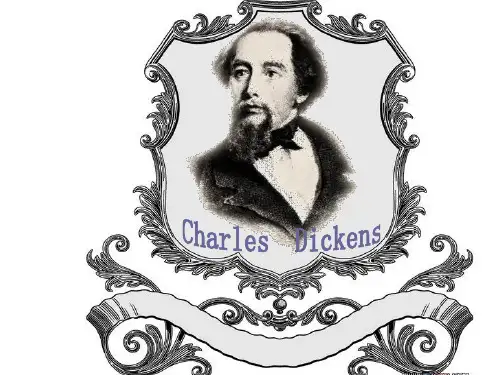

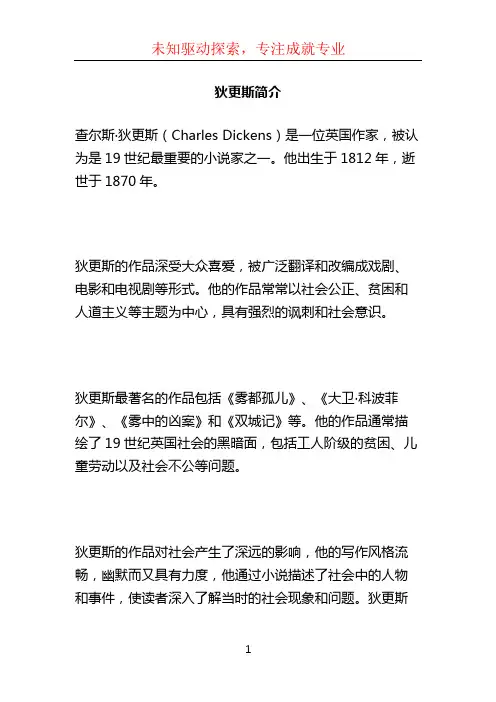
狄更斯简介
查尔斯·狄更斯(Charles Dickens)是一位英国作家,被认为是19世纪最重要的小说家之一。
他出生于1812年,逝世于1870年。
狄更斯的作品深受大众喜爱,被广泛翻译和改编成戏剧、电影和电视剧等形式。
他的作品常常以社会公正、贫困和人道主义等主题为中心,具有强烈的讽刺和社会意识。
狄更斯最著名的作品包括《雾都孤儿》、《大卫·科波菲尔》、《雾中的凶案》和《双城记》等。
他的作品通常描绘了19世纪英国社会的黑暗面,包括工人阶级的贫困、儿童劳动以及社会不公等问题。
狄更斯的作品对社会产生了深远的影响,他的写作风格流畅,幽默而又具有力度,他通过小说描述了社会中的人物和事件,使读者深入了解当时的社会现象和问题。
狄更斯
的作品也反映了他对社会不平等和不公正的关注,并提出了一些改革的思考。
狄更斯的作品不仅在当时获得了巨大的成功和影响力,而且至今仍然受到广大读者的喜爱。
他的作品被视为文学经典,他的创作风格和创新的故事情节继续深深地影响着后来的作家。
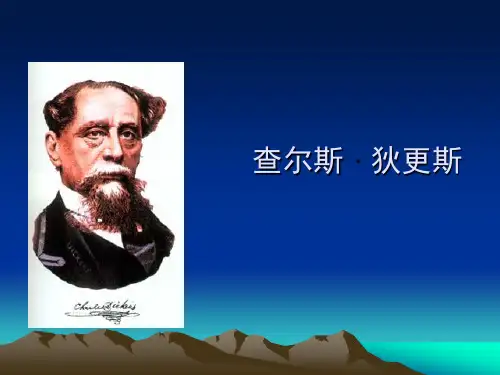
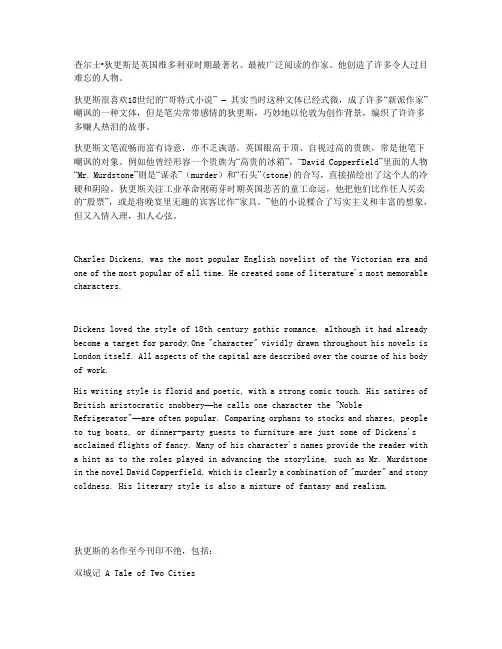
查尔士•狄更斯是英国维多利亚时期最著名、最被广泛阅读的作家。
他创造了许多令人过目难忘的人物。
狄更斯很喜欢18世纪的―哥特式小说‖–其实当时这种文体已经式微,成了许多―新派作家‖嘲讽的一种文体,但是笔尖常带感情的狄更斯,巧妙地以伦敦为创作背景,编织了许许多多赚人热泪的故事。
狄更斯文笔流畅而富有诗意,亦不乏诙谐。
英国眼高于顶、自视过高的贵族,常是他笔下嘲讽的对象。
例如他曾经形容一个贵族为―高贵的冰箱‖,―David Copperfield‖里面的人物―Mr. Murdstone‖则是―谋杀‖(murder)和―石头‖(stone)的合写,直接描绘出了这个人的冷硬和阴险。
狄更斯关注工业革命刚萌芽时期英国悲苦的童工命运,他把他们比作任人买卖的―股票‖,或是将晚宴里无趣的宾客比作―家具。
‖他的小说糅合了写实主义和丰富的想象,但又入情入理,扣人心弦。
Charles Dickens, was the most popular English novelist of the Victorian era and one of the most popular of all time. He created some of literature's most memorable characters.Dickens loved the style of 18th century gothic romance, although it had already become a target for parody.One "character" vividly drawn throughout his novels is London itself. All aspects of the capital are described over the course of his body of work.His writing style is florid and poetic, with a strong comic touch. His satires of British aristocratic snobbery—he calls one character the "Noble Refrigerator"—are often popular. Comparing orphans to stocks and shares, people to tug boats, or dinner-party guests to furniture are just some of Dickens's acclaimed flights of fancy. Many of his character's names provide the reader with a hint as to the roles played in advancing the storyline, such as Mr. Murdstone in the novel David Copperfield, which is clearly a combination of "murder" and stony coldness. His literary style is also a mixture of fantasy and realism.狄更斯的名作至今刊印不绝,包括:双城记 A Tale of Two Cities圣诞颂歌 A Christmas Carol大卫.科波菲尔 David Copperfield 艰难时世 Hard Times荒凉山庄 Bleak House董贝父子 Dombey and Son远大前程Great Expectations雾都孤儿 Oliver Twist。
狄更斯简介资料狄更斯简介查尔斯·狄更斯,全名查尔斯·约翰·赫法姆·狄更斯(英文原名:CharlesJohnHuffamDickens,1812年2月7日—1870年6月9日),英国作家。
主要作品有《大卫·科波菲尔》《匹克威克外传》《雾都孤儿》《老古玩店》《艰难时世》《我们共同的朋友》《双城记》等。
狄更斯1812年2月7日生于朴次茅斯市郊,出生于海军小职员家庭,少年时因家庭生活窘迫,只能断断续续入校求学。
后被迫到工场做童工。
15岁以后,当过律师事务所学徒、录事和法庭记录员。
20岁开始当报馆采访员,报道下议院。
1837年他完成了第一部长篇小说《匹克威克外传》,是第一部现实主义小说创作,后来创作才能日渐成熟,先后出版了《雾都孤儿》(1838)、《老古玩店》(1841)、《董贝父子》(1848)、《大卫·科波菲尔》(1850)、《艰难时代》(1854)、《双城记》(1859)《远大前程》(1861)等,1870年6月9日卒于罗切斯特附近的盖茨山庄。
狄更斯特别注意描写生活在英国社会底层的“小人物”的生活遭遇,深刻地反映了当时英国复杂的社会现实,为英国批判现实主义文学的开拓和发展做出了卓越的贡献。
他的作品对英国文学发展起到了深远的影响。
狄更斯人物经历1812年2月7日,查尔斯·狄更斯诞生于朴次茅斯。
父亲约翰·狄更斯是英国海军军需处职员,母亲名叫伊丽莎白·巴罗。
查尔斯是长子,姐姐范妮·狄更斯比他大两岁。
1813年12月,全家迁往绍思西。
1821年,查尔斯·狄更斯入威廉·贾尔斯办的学校读书,写作悲剧《印度君主米斯纳尔》。
1824年2月20日,约翰·狄更斯因负债被捕,关在马夏尔西债务人监狱。
数周后其妻伊丽莎白及幼年子女们也迁入其中。
此前,查尔斯·狄更斯已于2月9日入华伦黑鞋油作坊当童工,因此没有随家人住进监狱,独自在朋友家借宿。
Introduction of Charles Dickens/狄更斯生平简介Charles DickensCharles Dickens was born on February 7, 1812, in Portsea, England. His parents were middle-class, but they suffered financially as a result of living beyond their means. When Dickens was twelve years old, his family’s dire straits forced him to quit school and work in a blacking factory, a place where shoe polish is made. Within weeks, his father was put in debtor’s prison, where Dickens’s mother and siblings eventually joined him. At this point, Dickens lived on his own and continued to work at the factory for several months. The horrific conditions in the factory haunted him for the rest of his life, as did the experience of temporary orphanhood. Apparently, Dickens never forgot the day when a more senior boy in the warehouse took it upon himself to instruct Dickens in how to do his work more efficiently. For Dickens, that instruction may have represented the first step toward his full integration into the misery and tedium of working-class life. The more senior boy’s name was Bob Fagin. Dickens’s residual resentment of him reached a fevered pitch in the characterization of the villain Fagin in Oliver Twist.After inheriting som e money, Dickens’s father got out of prison and Charles returned to school. As a young adult, he worked as a law clerk and later as a journalist. His experience as a journalist kept him in close contact with the darker social conditions of the Industrial Revolution, and he grew disillusioned with the attempts of lawmakers to alleviate those conditions. A collection of semi-fictional sketches entitled Sketches by Boz earned him recognition as a writer. Dickens became famous and began to make money from his writing when he published his first novel, The Pickwick Papers, which was serialized in 1836 and published in book form the following year.In 1837, the first installment of Oliver Twist appeared in the magazine Bentley’s Miscellany, which Dickens was then editing. It was accompanied by illustrations by George Cruikshank, which still accompany many editions of the novel today. Even at this early date, some critics accused Dickens of writing too quickly and too prolifically, since he was paid by the word for his serialized novels. Yet the passion behind Oliver Twist, animated in part by Dickens’s own childhood experiences and in part by his outrage at the living conditions of the poor that he had witnessed as a journalist, touched his contemporary readers. Greatly successful, the novel was a thinly veiled protest against the Poor Law of 1834, which dictated that all public charity must be channeled through workhouses.In 1836, Dickens married Catherine Hogarth, but after twenty years of marriage and ten children, he fell in love with Ellen Ternan, an actress many years his junior. Soon after, Dickens and his wife separated, ending a long series of marital difficulties. Dickens remained a prolific writer to the end of his life, and his novels—among them Great Expectations, A Tale of Two Cities, A Christmas Carol, David Copperfield, and Bleak House—continued to earn critical and popular acclaim. He died of a stroke in 1870, at the age of 58, leaving The Mystery of Edwin Drood unfinished.The Poor Laws: Oliver Twist’s Social CommentaryOliver Twist opens with a bitter invective directed at the nineteenth-century English Poor Laws. These laws were a distorted manifestation of the Victorian middle class’s emphasis on the virtues of hard work. England in the 1830s was rapidly undergoing a transformation from an agricultural, rural economy to an urban, industrial nation. The growing middle class had achieved an economic influence equal to, if not greater than, that of the British aristocracy.In the 1830s, the middle class clamored for a share of political power with the landed gentry, bringing about a restructuring of the voting system. Parliament passed the Reform Act, which granted the right to vote to previously disenfranchised middle-class citizens. The middle class was eager to gain social legitimacy. This desire gave rise to the Evangelical religious movement and inspired sweeping economic and political change.In the extremely stratified English class structure, the highest social class belonged to the “gentleman,” an aristocrat who did not have to work for his living. The middle class was stigmatized for having to work, and so, to alleviate the stigma attached to middle-class wealth, the middle class promoted work as a moral virtue. But the resulting moral value att ached to work, along with the middle class’s insecurity about its own social legitimacy, led English society to subject the poor to hatred and cruelty. Many members of the middle class were anxious to be differentiated from the lower classes, and one way to do so was to stigmatize the lower classes as lazy good-for-nothings. The middle class’s value system transformed earned wealth into a sign of moral virtue. Victorian society interpreted economic success as a sign that God favored the honest, moral virtue of the successful individual’s efforts, and, thus, interpreted the condition of poverty as a sign of the weakness of the poor individual. The sentiment behind the Poor Law of 1834 reflected these beliefs. The law allowed the poor to receive public assistance only if they lived and worked in established workhouses. Beggars risked imprisonment. Debtors were sent to prison, often with their entire families, which virtually ensured that they could not repay their debts. Workhouses were deliberately made to be as miserable as possible in order to deter the poor from relying on public assistance. The philosophy was that the miserable conditions would prevent able-bodied paupers from being lazy and idle bums.In the eyes of middle-class English society, those who could not support themselves were considered immoral and evil. Therefore, such individuals should enjoy no comforts or luxuries in their reliance on public assistance. In order to create the misery needed to deter immoral idleness, families were split apart upon entering the workhouse. Husbands were permitted no contact with their wives, lest they breed more paupers. Mothers were separated from children, lest they impart their immoral ways to their children. Brothers were separated from their sisters because the middle-class patrons of workhouses feared the lower class’s “natural” inclination toward incest. In short, the state undertook to become the surrogate parents of workhouse children, whether or not they were orphans. Meals served to workhouse residents were deliberately inadequate, so as to encourage the residents to find work and support themselves.Because of the great stigma attached to workhouse relief, many poor people chose to die in the streets rather than seek public aid. The workhouse was supposed to demonstrate the virtue of gainful employment to the poor. In order to receive public assistance, they had to pay in suffering and misery. Victorian values stressed the moral virtue of suffering and privation, and the workhouse residents were made to experience these virtues many times over.Rather than improving what the middle class saw as the questionable morals of the able-bodied poor, the Poor Laws punished the most defenseless and helpless members of the lower class. The old, the sick, and the very young suffered more than the able-bodied benefited from these laws. Dickens meant to demonstrate this incongruity through the figure of Oliver Twist, an orphan born and raised in a workhouse for the first ten years of his life. His story demonstrates the hypocrisy of the petty middle-class bureaucrats, who treat a small child cruelly while voicing their belief in the Christian virtue of giving charity to the less fortunate.Dickens was a lifelong champion of the poor. He himself suffered the harsh abuse visited upon the poor by the English legal system. In England in the 1830s, the poor truly had no voice, political or economic. In Oliver Twist, Dickens presents the everyday existence of the lowest members of English society. He goes far beyond the expe riences of the workhouse, extending his depiction of poverty to London’s squalid streets, dark alehouses, and thieves’ dens. He gives voice to those who had no voice, establishing a link between politics and literature with his social commentary.‹ Charles Dickens向上Motifs of Oliver Twist/雾都孤儿的中心思想›»添加新评论。
狄根思简介英文版Dickens, Charles John Huffam (1812-1870), also known as Boz, was the foremost English novelist of the Victorian era, as well as a vigorous social campaigner.His works enjoyed unprecedented popularity during his lifetime, and by the twentieth century critics and scholars had recognised him as a literary genius. His novels and short stories continue to be widely popular.Born in Portsmouth, Dickens left school to work in a factory after his father was thrown into debtors' prison. Though he had little formal education, his early impoverishment drove him to succeed. He edited a weekly journal for 20 years, wrote 15 novels and hundreds of short stories and non-fiction articles, lectured and performed extensively, was an indefatigable letter writer, and campaigned vigorously for children's rights, education, and other social reforms.Dickens's literary success began with the 1836 serial publication of The Pickwick Papers. Within a few years he had become an international literary celebrity, famous for his humour, satire, and keen observation of character and society. His novels, most published in monthly or weekly instalments, pioneered the serial publication of narrative fiction, which became the dominant Victorian mode for novel publication. The instalment format allowed Dickens to evaluate his audience's reaction,and he often modified his plot and character development based on such feedback.Dickens's novels are known for their social commentary and critique of Victorian society. His characters often represent the various strata of English society and reflect the changing landscape of nineteenth-century England. His works include Oliver Twist, David Copperfield, Great Expectations, A Tale of Two Cities, Bleak House, Hard Times, Nicholas Nickleby, The Old Curiosity Shop, and Little Dorrit, among others.。